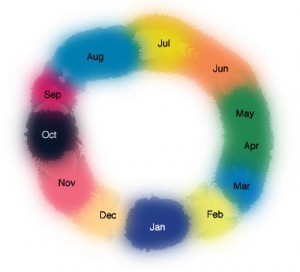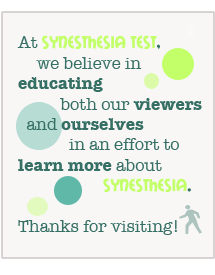Symptoms of Synesthesia
The symptoms of synesthesia go beyond tasting color or smelling sound. Certain senses are undifferentiated, which means that they are intertwined for certain triggers. Studies show that only one out of two thousand people are synesthetes, and it is more common among females. In fact, there’s a 6:1 ratio of female to male synesthetes. The condition is believed to be genetic, occurring more commonly for left-handed individuals. It is common for a synesthete to pursue a career that demands creativity – the arts, for example. Synesthesia is NOT considered a disease. Those affected usually carry an above average intelligence and the chance of them having mental disorders is not greater than that of any other person.
Some scientists believe that the condition may develop before a child is four months old. The reactions are automatic, and a child who has grown accustomed to the sensory stimulation may not interpret them as irregular or different from the norm. Parents may suspect that their child has the condition when he or she displays any of the following synesthesia symptoms.
Irregular Sensory Experiences
This is the most determining of the symptoms of synesthesia, as it is also the very definition of the condition. As mentioned, a child who experiences synesthesia symptoms will most likely not recognize the condition, but those around him will be able to suspect it if his general expressions imply out of the ordinary sensory experiences. An adult will be able to determine more easily if he or she has synesthesia, as they will have enough knowledge to know that “eyes cannot taste”, “ears cannot see”, and so on. Since there are numerous types of synesthesia, this is one of the symptoms which will not be the same for each person.

Consistent Reactionary Triggers
The same trigger will always cause the same senses to intertwine. A synesthete will not experience two different reactions from the same trigger. Because of this, test-retest is often used to determine synesthesia. Test-retest is where a person will identify characteristics with a set of objects twice, and the results be the same when a test is confirmatory.
Involuntary and Automatic Perception
One very telling synesthesia symptom is the involuntary, automatic nature of the perceptions. Psychologists make use of tests that measure reaction time in order to determine if a person is a synesthete. For example, a person with grapheme to color synesthesia will be able to determine automatically what color certain letters are. If the person being tested expends mental effort to recall the color that they previously assigned to a given letter, they are most likely not synesthetic. Sorry folks, synesthete isn’t something you can fake.
Simple and Objective Sensations
According to Cytowic, perceptions are “durable and generic, never pictorial or elaborated”. This means that visual synesthetic sensations will consist of a geometric pattern or a color, rather than a complex visualization. This puts an end to certain myths surrounding the visualizations that come with particular types of the neural condition. A given sound probably won’t trigger a flock of imaginary birds in “V” formation – you get the idea.




